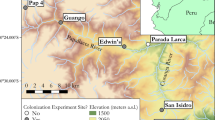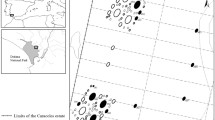Abstract
Understanding the factors that underlie colonization success is crucial both for ecological theory and conservation practices. The most effective way to assess colonization ability is to introduce experimentally different sets of individuals in empty patches of suitable habitat and to monitor the outcome. We translocated mated female waterstriders, Aquarius najas, into 90 streams that were not currently inhabited by the species. We manipulated sizes of propagules (from 2 to 16 mated females) and numbers of origin populations (one or two). Three origin populations were genetically different from each other, but they were less than 150 km from the streams of translocation. The results demonstrate clearly that both the larger propagule size and the high number of source populations have positive effects on the probability of colonizing a new stream. Thus, in addition to the stochastic factors related to the propagule size it may be essential to consider also the diversity of genetic origin for colonization success.

Similar content being viewed by others
References
Ahlroth P (1999) Dispersal and life-history differences between waterstrider (Aquarius najas) populations. Biol Res Rep Univ Jyväskylä 1–36
Ahlroth P, Alatalo RV, Hyvärinen E, Suhonen J (1999) Geographical variation in wing polymorphism of the waterstrider Aquarius najas (Heteroptera, Gerridae). J Evol Biol 12:156–160
Berggren Å (2001) Colonization success in roesel’s bush-cricket Metrioptera roeseli: the effect of propagule size. Ecology 82:274–280
Ebenhart T (1989) Bank vole (Clethrinomys glareolus (Schreber 1789)) propagules of different sizes and island colonisation. J Biogeogr 16:173–180
Ebert D, Haag C, Kirkpatrick M, Riek M, Hottinger JW, Pajunen VI (2002) A selective advantage to immigrant genes in a Daphia metapopulation. Science 295:485–488
Griffith B, Scott JM, Carpenter JW, Reed C (1989) Translocation as a species conservation tool: status and strategy. Science 245:477–480
Hanski I, Pöyry J, Pakkala T, Kuussaari M (1995a) Multiple equilibria in metapopulation dynamics. Nature 377:618–621
Hanski I, Pakkala T, Kuussaari M, Lei G (1995b) Metapopulation persistence of an endangered butterfly in a fragmented landscape. Oikos 72:21–28
Harrison S, Murphy DD, Ehrich PR (1988) Distribution of the Way checkerspot butterfly, Euphydryas editha bayensis: evidence for a metapopulation model. Am Nat 132:360–382
Huldén L (1979) Gerris najas DeGeer 1773 (Heteroptera Gerridae) populationsdynamik och utbredningshistoria I Finland. Masters thesis, University of Helsinki, Finland
Korkeamäki E, Suhonen J (2002) Distribution and habitat specialization of species affect local extinction in dragonfly Odonata populations. Ecography 25:459–465
Kuussaari M, Nieminen M, Hanski I (1996) An experimental study of migration in the Glanville fritillary butterfly Melitaea cinxia. J Anim Ecol 65:791–801
Lammes T, Rinne V (1990) Maps of the provincial distribution of Finnish Heteroptera. Entomol Fenn 1:209–220
Lande R (1988) Genetics and demography in biological conservation. Science 241:1455–1460
Leberg PL (1993) Strategies for population reintroduction: Effects of genetic variability on population growth and size. Conserv Biol 7:194–199
Linnavuori R (1966) Suomen eläimet. Nivelkärsäiset 1. Anim Fenn 10
Madsen T, Shine R, Olsson M, Wittzell H (1999) Restoration of an inbred adder population. Nature 402:34–35
McCauley DE (1991) Genetic consequences of local population extinction and recolonisation. Trends Ecol Evol 6:5–8
Newman D, Pilson D (1997) Increased probability of extinction due to decreased genetic effective population size: experimental populations of Clarcia pulchella. Evolution 51:354–362
Rassi P, Alanen A, Kanerva T, Mannerkoski I (eds) (2001) Suomen lajien uhanalaisuus 2000. Ympäristöministeriö and Suomenympäristökeskus, Helsinki
Saccheri I, Kuussaari M, Kankare M, Vikman P, Fortelius W, and Hanski I (1998) Inbreeding and extinction in a butterfly metapopulation. Nature 392:491–494
Schoener TW, Schoener A (1983) The time to extinction of a colonizing propagule of lizards increases with island area. Nature 302:332–334
Schoener TW, Spiller DA (1987) High population persistence in a system with high turnover. Nature 330:474–477
Schoener TW, Spiller DA (1995) Effect of predators and area on invasion: an experiment with island spiders. Science 267:1811–1813
Shaffer ML, Samson FB (1985) Population size and extinction: a note on determining critical population sizes. Am Nat 125:144–152
Veltman CJ, Nee S, Crawley MJ (1996) Correlates of introduction success in exotic New Zealand birds. Am Nat 147:542–557
Vepsäläinen K (1973) The distribution and habitats of Gerris Fabr. species (Heteroptera, Gerridae) in Finland. Ann Zool Fenn 10:419–444
Vepsäläinen K, Krajewski S (1986) Identification of the waterstrider (Gerridae) nymphs of northern Europe. Ann Entomol Fenn 52: 63-77
Vepsäläinen K, Nummelin M (1985) Female territoriality in the waterstriders Gerris najas and G. cinereus. Ann Zool Fenn 22:433–439
Acknowledgements
We thank trainees (Raimo, Mirka) and students (Irma, Susanna, Tero, Jarno, Juha, Marjo) who have helped us during the field season. Katri Kärkkäinen and Mervi Ahlroth provided valuable comments on the manuscript. This work was financed by the Academy of Finland (in two projects: “Local adaptations in small populations” and FIBRE-project: “Viability of populations, assessment of biodiversity and conservation value”) grants to Rauno V. Alatalo. Anne Holopainen was funded by The Entomological Society of Finland and Kuopion Luonnon Ystäväin Yhdistys ry, and Betty Väänäsen rahasto.
Author information
Authors and Affiliations
Corresponding author
Rights and permissions
About this article
Cite this article
Ahlroth, P., Alatalo, R.V., Holopainen, A. et al. Founder population size and number of source populations enhance colonization success in waterstriders. Oecologia 137, 617–620 (2003). https://doi.org/10.1007/s00442-003-1344-y
Received:
Accepted:
Published:
Issue Date:
DOI: https://doi.org/10.1007/s00442-003-1344-y




